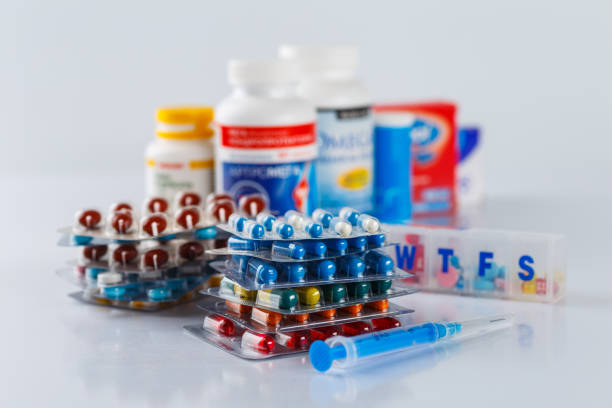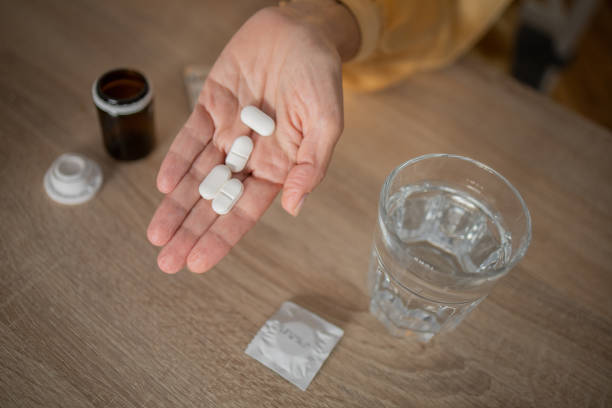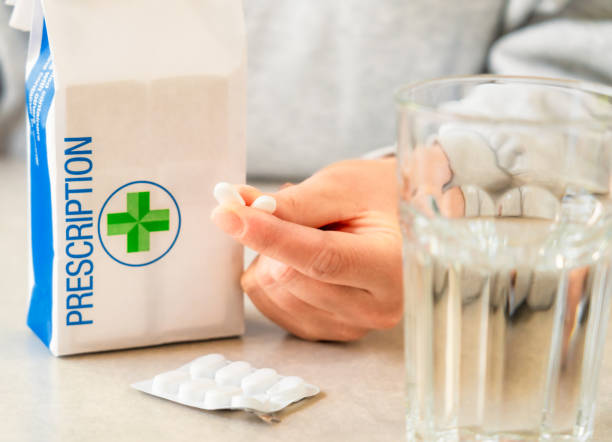
Acyclovir is an antiviral agent that is used to treat viral infections caused by herpes simplex virus (HSV). This drug is FDA-approved for treating genital herpes infection and HSV encephalitis. Non-FDA-approved indications of Acyclovir include herpes zoster (shingles), varicella zoster (chickenpox), and mucocutaneous HSV. This medicine is also prescribed to treat genital herpes outbreaks. In people experiencing frequent outbreaks, Acyclovir is given to help lessen the count of future episodes.
Importance of Studying Acyclovir Use in Pediatric Patients
Acyclovir is an antiviral medication. It is not a cure for herpes infections but it effectively treats the symptoms. The viruses stay inside the body and may cause infection in the future. This drug lessens the length and severity of these outbreaks. It is important to study the use of Acyclovir in pediatric patients as improper use of this medication as well as any other antiviral drug can be dangerous.
Acyclovir was licensed by the USFDA (US Food and Drug Administration in 1982. This medication has proven significant as a pivotal antiviral drug for various reasons. Acyclovir is highly particular for cells that are infected by the varicella-zoster virus and herpes simplex virus which enhances its efficacy. Moreover, the toxicity profile of this drug is very favorable, weakening its potential for adverse events.
Acyclovir is a great combination of extreme benefits and minimal risk that ranks it among the safest antiviral drugs available for the treatment of life-threatening viral infections. However, just like any other therapeutic agent, unfortunate side effects may occur with the use of Acyclovir associated with the dose administered and the hydration status. The optimal dosage of this medication is different for different age groups and should be given consciously.
Purpose of The Guidelines and Considerations
Acyclovir is widely prescribed to children for the treatment of varicella-zoster virus (chickenpox). It prevents the replication of varicella-zoster virus and holds great potential to eliminate varicella virus and provide rapid relief from the symptoms. However, the use of Acyclovir by the oral route in pediatric patients younger than 2 years of age is limited because of the lack of pharmacokinetic information.
There are a limited number of studies performed using oral Acyclovir in pediatric patients and the effects occurred in children as well as in adults were similar. It is advised to use Acyclovir in pediatric patients only when prescribed by a doctor or healthcare professional. The purpose of Acyclovir guidelines and considerations in children is to assure the safety and efficacy of this drug.
Pharmacology of Acyclovir
Acyclovir works by preventing the spread of infection-causing viruses in the body. It is phosphorylated in infected cells by a viral-induced thymidine kinase. Acyclovir monophosphate is phosphorylated to diphosphate and triphosphate forms by cellular enzymes in the infected host cell where the medication is concentrated.
Mechanism of Action
Acyclovir is a synthetic nucleoside analog. It integrates itself into viral DNA, averting further synthesis. Viral and cellular enzymes transform it into acyclovir triphosphate, which impedes DNA synthesis and viral replication.
Pharmacokinetics in Children Vs. Adults
The kidneys defecate acyclovir medication via glomerular filtration and tubular secretion. Dosage adjustment is needed for patients with renal failure. Preliminary records demonstrated that the kinetics of Acyclovir in neonates were possibly strongly modified as compared to adults. However, Acyclovir bioavailability and interindividual variability of its pharmacokinetics could not be well illustrated.
Dosage Forms Available
- Acyclovir medication comes in various dosage forms including:
- Tablet (400mg and 800 mg)
- Capsule (200 mg)
- Oral suspension (200mg/5mL)
- Powder for solution (500mg/vial and 1000mg/vial)
- Solution (50mg/mL)
Indications for Acyclovir in Pediatric Patients
Acyclovir agent is given to treat herpes infections such as genital herpes. Common viral infections treated with Acyclovir are:
- Genital herpes
- Herpes zoster
- Herpes encephalitis
- Varicella zoster
- Herpes labialis and herpes genitalis
- Prophylaxis of herpes simplex (immunocompromised patients)
Herpes Simplex Virus (HSV)
Herpes simplex virus causes genital herpes, oral herpes, and infections in other body parts. Many people do not experience symptoms however a common symptom of these infections is the appearance of fluid-filled blisters on the skin.
HSV is extremely contagious and it transfers from infected person to other people through direct skin contact. HSV infection occurs when you are exposed to the virus through the skin and mucous membranes. The viruses join your cells to create more copies of themselves.
For diagnosis, a simple blood test is required to detect if you have herpes simplex virus in your body. Once you are infected with herpes simplex virus, it remains in your body for a lifetime. Usually, it stays inside the body in deactivated form but may reactivate and lead to outbreaks in the future. Antiviral drugs including Acyclovir can help treat initial outbreaks as well as help you manage these infections long term.
Varicella-Zoster Virus (VZV)
Varicella zoster virus belongs to the herpes virus family that causes chickenpox and shingles. The virus remains in the body (nerve cells) even after you recover from these infections and it can reactivate in later years. Getting vaccinated with chickenpox vaccination can prevent these infections.
VZV infections cause painful and itchy rashes and fever accompanied by other symptoms. For that reason, people who had chickenpox when they were kids are at risk of experiencing shingles in adult age.
Symptoms of varicella-zoster virus infections depend on where you get infected however the common symptoms may include:
- Itchy or painful rash with fluid-filled blisters
- Fever
- Burning sensation in the skin
- Headache
- Redness and swelling in eyes
- Light sensitivity
Usually, VZV infections are diagnosed by healthcare professionals depending on your rash and symptoms. In some cases, you may have to give samples of fluid or tissue from the rash and get it tested for the virus.
Healthcare providers usually treat VZV infections with antiviral medications including Acyclovir. It works best when you take it as you notice the first sign of infection. It may not work as it should 24 hours after the initial symptom appears.
Cytomegalovirus (CMV)
Once a person is exposed to cytomegalovirus, it stays in your body for life. In healthy people it rarely causes symptoms thus many people do not even know that they are infected with cytomegalovirus. CMV infection can be fatal in patients with weak immune systems particularly those who have had stem cells, bone marrow, or organ transplants.
For pregnant women who have weak immune systems, CMV infection can be dangerous. If pregnant women have active CMV infection they can pass the virus to their babies and they may experience symptoms.
People who are prone to experience symptoms of CMV include:
- Newborn babies who are infected with CMV before they are born (congenital CMV).
- Infants who are infected with CMV during birth or shortly after they are born (perinatal CMV). These babies may be infected through breastfeeding.
- CMV transfers from infected people to other healthy people through body fluids such as saliva, urine, blood, semen, and breast milk. There is no cure available for these infections however medications can help treat and manage symptoms efficiently.
Off-Label Uses
- Generally, the oral Acyclovir medication is prescribed as a short-term treatment for certain indications that are not FDA-approved. Acyclovir is prescribed off-label for the treatment of;
- Oral HSV infections and recurrent episodes of herpes
- Herpes zoster ophthalmicus (herpes zoster virus affecting the eyes or around the eyes)
- HSV keratitis (infection in the cornea of the eyes)
Dosing Guidelines

Typical Pediatric Dose for Herpes Simplex-Congenital
Neonatal herpes (birth to 3 months):
10 mg/kg IV every 8 hours for 10 days (manufacturer’s recommendation) and 20 mg/kg IV every 8 hours (CDC recommendation). The duration of therapy for disease limited to skin and mucous membranes is 14 days and for disseminated disease or disease involving CNS is 21 days. Oral suppressive therapy of 300 mg/m2 thrice a day is recommended for 6 months.
Neonates born to HSV-infected women near term need to be treated because of the high risk of infection. Infants exposed to HSV during birth need to be treated by a pediatric infectious-disease specialist.
Typical Pediatric Dose for Herpes Simplex Mucocutaneous/Immunocompetent Host
The first episode of genital herpes:
For less than 12 years of age, 40-80 mg/kg/day orally divided into 3 to 4 doses for 5 to 10 days. Maximum dose is 1000 mg/day.
For 12 years and older, 200 mg orally every 4 hours 5 times a day, or 400 mg orally 3 times daily for 7 to 10 days.
Severe infection or complications requiring hospitalization:
For less than 12 years of age 10 mg/kg IV every 8 hours for 7 days and for 12 years of age and above 5 mg/kg IV every 8 hours for 7 days.
Recurrent episode of genital herpes:
For those below 12 years of age, 20-25 mg/kg orally twice a day. Maximum dose is 400 mg/day. For those above 12 years of age, 200 mg orally 5 times a day or 800 mg orally twice a day for 5 days.
All patients who experience the first episode of genital herpes should get antiviral therapy as initial episodes may lead to prolonged clinical illness even among patients with mild symptoms initially. Therapy should be started at the earliest signs of primary infection. IV therapy is recommended for patients with severe infections.
Typical Pediatric Dose for Herpes Simplex Encephalitis
For children aged 3 months to 12 years, 10-20 mg/kg IV every 8 hours, and for children aged 12 years and older, 10 mg/kg IV every 8 hours for 10 to 21 days as your healthcare provider prescribes.
The CDC (Center for Disease Control and Prevention) recommends IV therapy for the treatment of HSV encephalitis for 21 days. Acyclovir medication is a drug of choice for the treatment of local and disseminated herpes simplex infections in pediatric patients.
Typical Pediatric Dose for Herpes Simplex Mucocutaneous Immunocompromised Host
For less than 12 years of age, 10 mg/kg IV every 8 hours for 7 days, and for 12 years of age and older 5 mg/kg IV every 8 hours for 7 days.
Concomitant HIV infection for mild symptomatic Gingivostomatitis, 20 mg/kg orally 4 times a day for 7 to 10 days. Maximum dose is 400 mg. For moderate to severe gingivostomatitis 5 to 10 mg/kg IV 3 times a day. The healthcare professional may advise to switch to oral therapy after lesions start to regress and treat lesions until they heal completely.
Typical Pediatric Dose for Herpes Zoster
Immunocompetent host: Parenteral less than 1 year of age 10 mg/kg IV every 8 hours for 7 to 10 days and for 1 year and older age 500 mg/m2 IV every 8 hours for 7 to 10 days. For patients 12 years and older age 800 mg orally 5 times a day for 5 to 7 days.
Immunocompromised host: 10 mg/kg IV every 8 hours for 7 to 10 days.
Typical Pediatric Dose for Varicella-Zoster
Immunocompetent host: For 2 years above (40 kg or less body weight) 20 mg/kg orally 4 times a day for 5 days. For patients above 40 kg body weight, 800 mg orally 4 times a day for 5 days. The maximum daily dose is 3200 mg/day.
Immunocompromised host: For kids below 1 year of age 10 mg/kg IV 3 times a day for 7 to 10 days and kids 1 year and older age 500 mg/m2 IV thrice a day for 7 to 10 days and until no new lesions for 48 hours.
HIV-exposed and infected pediatric patients: For mild disease with moderate or no immune compression 20 mg/kg orally 4 times a day for 7 to 10 days. For severe immune suppression 10 mg/kg or 500 mg/m2 IV every 8 hours for 7 to 10 days and until no new lesions for 48 hours.
Acyclovir therapy should be commenced at the earliest sign of chickenpox, preferably not later than 24 hours of the onset of rash. For patients aged 1 year and older body surface area may be considered for dosing instead of body weight.
Typical Pediatric Dose for Herpes Simplex Suppression
For neonatal (below 1 year of age) 300 mg/m2 orally thrice a day for 6 months. Secondary prophylaxis in HIV-exposed or infected patients 20 mg/kg orally twice a day. The maximum dose is 800 mg.
Suppressive therapy following neonatal HSV infection treatment involving CNS or skin, mouth, and eyes may stop cutaneous recurrences and probably offer superior neurodevelopmental results.
Typical Pediatric Dose for Herpes Simplex Labialis (Cold Sores)
Concomitant HIV infection: 20 mg/kg orally 4 times a day for 5 days. Maximum dose is 400 mg. For adolescents, 400 mg orally thrice a day for 5 to 10 days.
The safety of buccal tablets in pediatric patients has not been established. Using buccal tablets in younger children may lead to the risk of choking. For more details discuss with your healthcare provider.
Age-Related Dosing Adjustments
Elderly patients are more likely to experience reduced renal function thus they may require dose reduction. Obese patients need to be dosed at the prescribed doses using their IBW (Ideal Body Weight).
Considerations for Renal Function
For CrCl 0 to 10 mL/min/1.73 m2 (oral): If the normal dose is 200 mg every 4 hours 5 times a day, reduce it to 200 mg every 12 hours. If the normal dose is 400 mg every 12 hours, reduce it to 200 mg every 12 hours. If the normal dose is 800 mg every 4 hours 5 times a day, reduce it to 800 mg every 12 hours.
For CrCl 10 to 25 mL/min/1.73 m2 (oral): If the normal dose is 800 mg every 4 hours 5 times a day, reduce it to 800 mg every 8 hours.
For CrCl 0 to 10 mL/min/1.73 m2 (IV): It is advised to give 50% of the dose every 24 hours.
For CrCl 10 to 25 mL/min/1.73 m2 (IV): It is advised to give 100% of the dose every 24 hours.
For CrCl 25 to 50 mL/min/1.73 m2 (IV): It is advised to give 100% of the dose every 12 hours.
For CrCl greater than 50 mL/min/1.73 m2 (IV): It is advised to give 100 of the dose every 8 hours.
Administration and Monitoring
Acyclovir is administered through various routes. It can be administrated orally (by mouth), intravenously (IV), and topically (externally on the skin).
Guidelines for Infusion and Hydration
The typical Acyclovir dose is 5-10 mg per kg of body weight, slowly injected into a vein over at least one hour and repeated every 8 hours for 5 to 10 days. For pediatric patients up to 12 years of age, the exact dosage should be based on their body weight and must be determined by a healthcare provider.
Acyclovir oral tablets can be taken with or without food through mouth with a glass of water. Additionally, it is essential to maintain adequate hydration while taking this medication.
Parenteral:
Administer via IV infusion over at least an hour, infused concentration should not exceed 7 mg per mL. It is not advised to administer Acyclovir by rapid or bolus IV injections as it is not for IM or subcutaneous injection.
Reconstitution/storage/preparation techniques:
For IV infusion only, it must be diluted before use. Reconstitute with sterile water for injection and use within 12 hours. Do not use bacteriostatic water for injection containing benzyl alcohol or parabens. Refrigeration of reconstituted solution may result in precipitate formation. Infusion concentrations must be 7 mg/mL or lower, once diluted make sure to use it within 24 hours.
IV compatibility:
For IV administration standards, commercially available electrolyte and glucose solutions are suitable. Biological or colloidal fluids such as protein solutions and blood products are not recommended.
Monitoring Parameters
Acyclovir is an extremely effective treatment for herpes simplex viral infections and prophylaxis of varicella zoster. Accumulation of this medication has been associated with neurotoxicity manifesting lethargy, agitation, or hallucinations.
Acyclovir may cause kidney damage, this it is advised to monitor for renal failure. It is recommended to assess renal function before you begin with Acyclovir treatment. A renal function test should be performed 48-72 hours after Acyclovir infusion.
Usually, acute kidney injury from Acyclovir may develop within 12-48 hours of taking this medicine. The signs include a quick increase in serum creatinine levels. Renal inadequacy can be symptomless however, it may cause vomiting, nausea, flank or abdominal pain, and reduced urine output.
Side Effects in Pediatric Patients
Common side effects of this drug include diarrhea, nausea, vomiting, headache, and loss of appetite. Usually, these symptoms disappear as the child’s body adjusts to the drug. If any of these side effects lasts longer, talk to your doctor or healthcare provider.
Rare But Serious Adverse Reactions
Rare adverse effects in pediatric patients which can be serious include skin rash, sore throat, leg pain, dizziness, weakness, numbness, or tingling in hands or feet.
Management of Side Effects
Follow the dosage instructions carefully. Take this medication precisely as recommended by your healthcare professional. Drink plenty of water and prefer a liquid diet to avoid dehydration. If you experience side effects, discuss them with your healthcare professional and ask how you can manage them.
Special Considerations

Acyclovir is authorized for the acute management of varicella virus in adults as well as children. Specific groups that are considered at greatest risk of complications are pregnant women, infants less than one year of age, adolescents, and patients using high-dose corticosteroids. Elderly patients with the illness have a more severe clinical course
Drug Interactions
Certain medications should not be used together as combining them may increase the risk of side effects or cause drug interactions. Similarly, some medicines should not be used with Acyclovir. In this case, your healthcare professional must manage your medications and their dosage to avoid any interactions and complications.
Medicines which should not be used along with Acyclovir include:
- Fezolinetant
- Bupropion
- Dichlorphenamide
- Emtricitabine
- Fexinidazole
- Foscarnet
- Leflunomide
- Nitisinone
- Teriflunomide
- Vedadustat
- Warfarin
- Phenytoin
- Valproic acid
Safety in pregnant and breastfeeding mothers
Generally, Acyclovir is considered safe to use in pregnant women however it is recommended to consult a doctor before taking this medicine. Acyclovir is not known to be dangerous to the unborn child. It is considered safe to use during all trimesters during pregnancy. It can effectively reduce the severity of herpes, and chickenpox and prevent genital herpes flare up during pregnancy.
Acyclovir can be safely used while breastfeeding if your doctor recommends it and your baby is healthy. This medication passes into breast milk in small amounts and is unlikely to develop side effects.
Conclusion
Acyclovir is widely used to treat the symptoms of herpes virus infections (skin, brain, and mucous membranes), chickenpox, shingles, and widespread herpes virus infections in newborns. Although Acyclovir is considered safe for use in children there may be a risk you do not use it properly as prescribed by a healthcare provider. Acyclovir will not cure the infection but it relieves the pain, discomfort, and other symptoms effectively.
Acyclovir is prescribed to treat herpes simplex virus in infants. It is highly important to follow the guidelines provided for this medication. Improper use of this medication can lead to serious adverse effects. Make sure you take this medication only if your doctor prescribes it. A limited number of studies have been performed using oral Acyclovir in children and no difference was found in effects or problems in adults and pediatric patients.
References
Standard-Dose Versus High-Dose Acyclovir in Children Treated Empirically for Encephalitis: A Retrospective Cohort Study of Its Use and Safety
Intravenous Acyclovir is a treatment of choice for herpes simplex virus encephalitis. In 2006, the American Academy of Pediatrics updated its dosing recommendations of Acyclovir for patients aged 3 months to 12 years which is 60 mg/kg/day. The association between Acyclovir and toxicity is not clear.
Aim of the study:
The purpose of this study was to assess our institution’s experience with standard and high-dose Acyclovir for the empiric treatment of encephalitis.
Study design and setting:
This retrospective cohort study included pediatric patients aged 1 month to 18 years who were given Acyclovir as empiric treatment for encephalitis between 2005 and 2009 at a tertiary care children’s hospital. The patients with baseline renal impairment and without serum creatinine measurements before and during the treatment were excluded.
Key outcome measure:
The key outcome measure of this study was to compare the occurrence of renal; injury or renal failure among the children who were given standard versus high doses of Acyclovir.
Outcomes:
61 patients were included in this study, 32 standard-dose patients and 29 high-dose patients. No Statistical difference was found in the change in serum creatinine from baseline between kids who were given standard versus high doses of Acyclovir. 1 patient in the standard dose group and 3 patients in the high dose group developed renal injury or failure during the treatment. Patients with renal injury or failure were older and had a long-term stay and longer duration of therapy than patients without.
Conclusions:
The incidence of renal injury or renal failure was similar among the children who were given a standard dose and a high dose of Acyclovir.





